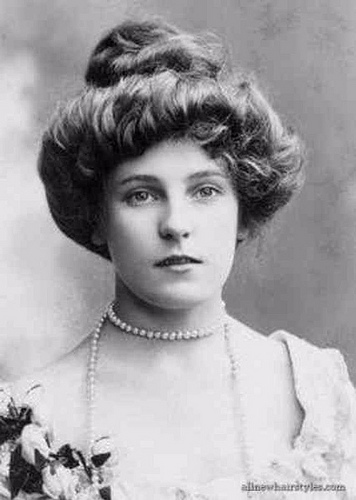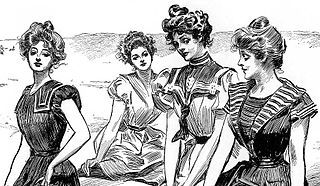2-3-4 Challenge Book Discussions #1 discussion
Murder on Sisters’ Row
>
Sisters’ Row History
date newest »
newest »
 newest »
newest »
Gibson Girl Knot

Gibson Girls at the Beach

The Gibson Girl began appearing in the 1890s and was the personification of the feminine ideal of physical attractiveness portrayed by the satirical pen-and-ink illustrations of illustrator Charles Dana Gibson during a 20-year period that spanned the late 19th and early 20th century in the United States and Canada. The artist saw his creation as representing the composite of "thousands of American girls." The artist believed that the Gibson Girl represented the beauty of American women:
"I'll tell you how I got what you have called the 'Gibson Girl.' I saw her on the streets, I saw her at the theatres, I saw her in the churches. I saw her everywhere and doing everything. I saw her idling on Fifth Avenue and at work behind the counters of the stores... [T]he nation made the type. What Zangwill calls the ‘Melting Pot of Races’ has resulted in a certain character; why should it not also have turned out a certain type of face?...There isn’t any ‘Gibson Girl,’ but there are many thousands of American girls, and for that let us all thank God."
The Gibson Girl image that appeared in the 1890s combined elements of older American images of Caucasian female beauty, such as the "fragile lady" and the "voluptuous woman". From the "fragile lady" she took the basic slender lines, and a sense of respectability. From the "voluptuous woman" she took a large bust and hips, but was not vulgar or lewd, as previous images of women with large busts and hips had been depicted. From this combination emerged the Gibson Girl, who was tall and slender, yet with ample bosom, hips and buttocks. She had an exaggerated S-curve torso shape achieved by wearing a swan-bill corset.
Images of her epitomized the late 19th- and early 20th-century Western preoccupation with youthful features and ephemeral beauty. Her neck was thin and her hair piled high upon her head in the contemporary bouffant, pompadour, and chignon ("waterfall of curls") fashions. The statuesque, narrow-waisted ideal feminine figure was portrayed as being at ease and stylish.

Gibson Girls at the Beach

The Gibson Girl began appearing in the 1890s and was the personification of the feminine ideal of physical attractiveness portrayed by the satirical pen-and-ink illustrations of illustrator Charles Dana Gibson during a 20-year period that spanned the late 19th and early 20th century in the United States and Canada. The artist saw his creation as representing the composite of "thousands of American girls." The artist believed that the Gibson Girl represented the beauty of American women:
"I'll tell you how I got what you have called the 'Gibson Girl.' I saw her on the streets, I saw her at the theatres, I saw her in the churches. I saw her everywhere and doing everything. I saw her idling on Fifth Avenue and at work behind the counters of the stores... [T]he nation made the type. What Zangwill calls the ‘Melting Pot of Races’ has resulted in a certain character; why should it not also have turned out a certain type of face?...There isn’t any ‘Gibson Girl,’ but there are many thousands of American girls, and for that let us all thank God."
The Gibson Girl image that appeared in the 1890s combined elements of older American images of Caucasian female beauty, such as the "fragile lady" and the "voluptuous woman". From the "fragile lady" she took the basic slender lines, and a sense of respectability. From the "voluptuous woman" she took a large bust and hips, but was not vulgar or lewd, as previous images of women with large busts and hips had been depicted. From this combination emerged the Gibson Girl, who was tall and slender, yet with ample bosom, hips and buttocks. She had an exaggerated S-curve torso shape achieved by wearing a swan-bill corset.
Images of her epitomized the late 19th- and early 20th-century Western preoccupation with youthful features and ephemeral beauty. Her neck was thin and her hair piled high upon her head in the contemporary bouffant, pompadour, and chignon ("waterfall of curls") fashions. The statuesque, narrow-waisted ideal feminine figure was portrayed as being at ease and stylish.
 Thank you, Jonetta. I looked up information on Sisters Row yesterday. I didn't find anything as interesting as the Gentleman's Directory Guide. And they tried to pass that off as a guide to help gentleman avoid such places? LOL
Thank you, Jonetta. I looked up information on Sisters Row yesterday. I didn't find anything as interesting as the Gentleman's Directory Guide. And they tried to pass that off as a guide to help gentleman avoid such places? LOLI like the Gibson Girl look. I was wondering what it looked like while I was reading.
 Thanks, Jonetta. I actually knew the Gibson Girl look, for decades. No idea how this bit of information got into my brain that young, but it remains with me, not a small wonder some days!
Thanks, Jonetta. I actually knew the Gibson Girl look, for decades. No idea how this bit of information got into my brain that young, but it remains with me, not a small wonder some days!
 Thanks Jonetta! I wanted to look up information while I was reading but always got too lazy (and too engrossed in the read) to go get my phone :P
Thanks Jonetta! I wanted to look up information while I was reading but always got too lazy (and too engrossed in the read) to go get my phone :PLOL at the Gentleman's Directory guide.
 Interesting information. Thanks Jonetta!
Interesting information. Thanks Jonetta!The sheer number of brothels really emphasizes just how desperate the lower class women of the time were.
 Another interesting tidbit I found out about Sister's Row and the surrounding area known as Satan's Circle, is the police called it the tenderloin district. It is said that police bragged that they could only afford chuck beef before Satan's Circle became their beat, but the bribes they received made it possible for them to put tenderloins on the table daily.
Another interesting tidbit I found out about Sister's Row and the surrounding area known as Satan's Circle, is the police called it the tenderloin district. It is said that police bragged that they could only afford chuck beef before Satan's Circle became their beat, but the bribes they received made it possible for them to put tenderloins on the table daily.
Thanks for that, Sharon! It probably explains how they came up with the name for that area in San Francisco, too.




Sisters’ Row, which was located on 25th Street, was a series of seven side-by-side brothels run by seven sisters, who had come to New York from a New England village seeking fame and fortune.
Sisters’ Row was considered the most expensive bordello in New York City. It was frequented by the blue bloods of society — only the rich could afford their prices. On certain days of the month, no man was admitted unless he had an engraved invitation, wore evening dress, and carried a bouquet of flowers. And on Christmas Eve, all the proceeds garnered that night on Sisters’ Row was donated to charity.
This high-class establishment was only one of the choices. A look at descriptions in The Gentleman’s Directory, a 55-page pocket guide published in 1870, gives an idea of the range of brothels in Satan’s Circus. The directory listed more than 150 Manhattan establishments, identifying 49 in Satan’s Circus and 23 on West 27th Street alone.
The Gentleman’s Directory professed to be a guide to help people avoid such places: “We point out the location of these places in order that the reader may know how to avoid them and that he may not select one of them for his boarding house when he comes to the city.” The detailed information on each house and its occupants provided by the directory belies this stated intention. Some houses were lauded, while critics didn’t mince words when there were house they didn’t like (or who refused to buy ads in the guide). Here are just some of the guidebooks entries, as they appeared in the original pocketbook:
105 W 25th St.
… is kept by Mrs. Kate Woods, better known among the aristocracy as Hotel De Wood. This is a 2 story brownstone house, furnished with the most costly and newest improvements. Her gallery of oil paintings alone cost $10, 000 ($170, 000 today). Rosewood furniture mimes mirrors, Parisian figures, etc… The house is furnished at a cost of $70, 000 ($1,119,950 today). She keeps three young ladies of rare personal attractions and her house receives the patronage of distinguished gentlemen from foreign countries. This is the best house in 25th St.
116 W 26th St
… is a parlor house kept by Sarah Wilbur, this house is most elegantly furnished, the proprietress is a very pleasant and agreeable lady, of a fun loving disposition. She has seven lady boarders, who are very affectionate and agreeable. Gentlemen seeking for pleasure, will be very agreeable entertained. This is a first class house.
127 W 26th St.
… is a ladies boarding house of the second class, kept by Madame Buemont. There is a report of a bear being kept in the cellar, but for what reason may be inferred. There is not anything else attractive about the place.
47 W 27th St
… is a ladies boarding house presided over by Jenny Mitchell, a very agreeable and entertaining lady, who has 4 highly accomplished young lady boarders. The house is furnished in a very elaborate manner, with every requisite for enjoyment. It is a first class house, quiet and orderly.
103 W 27th St.
Mrs Emma Brown…There is no attraction about this house. It has four boarders and rates second class.
104 W 27 St.
This house is kept by Miss Maggie Pierce, (better known as Little Maggie of 30 12th St.) The house is well furnished and fitted up in elegant style. The landlady is good-looking and very entertaining. She has 7 young lady boarder of pleasing manners and ready wit. This is a very quiet and orderly house.
105 W 27th St.
… is a second class establishment. It is asserted that the landlady and her servants are as sour as her wine.
107 W 27th St.
This house is kept by Miss Fanny Harvey; is newly frescoed, painted and furnished with the most costly furniture, carpets, mirrors and paintings. It has seven lady boarders, young, good-looking and accomplished; they are of a cheerful, lively disposition whose merry laugh resounds through the entire palace of beauty. This is a first class house in every respect; it is quiet and orderly.
123 W 27th St.
Miss Anna Manzoe. This is a first class Ladies Seminary, conducted by an accomplished and intelligent lady, who has a class of seven beautiful young lady scholars who do credit to her establishment. The house is newly furnished in a magnificent style, is very quiet and orderly, and first class in every respect.
128 W 27th St.
Mrs Lizzie Goodrich, the dashing brunette, whose smiling face is ever ready to welcome her patrons keeps this house. Mrs. Lizzie as she is generally called, has five good-looking lady boarders whose cheerful dispositions tend to drive away the blues. There is a regular physician attached to this house, and every attention is shown its visitors. As a first class house, it is neatly and comfortably fitted up, and is very quiet and orderly.
134 W 27th St.
Kate Davis’ boarding house has four boarders. The landlady, being of very sullen disposition, a visit there would be disagreeable to the visitor.
140 W 27th St.
Mrs Cutler… lets her rooms to enterprising young ladies.